The Bioacoustics Sensing Market is estimated to be valued at USD 6.5 billion in 2025 and is projected to reach USD 20.2 billion by 2035, registering a compound annual growth rate (CAGR) of 12.0% over the forecast period.
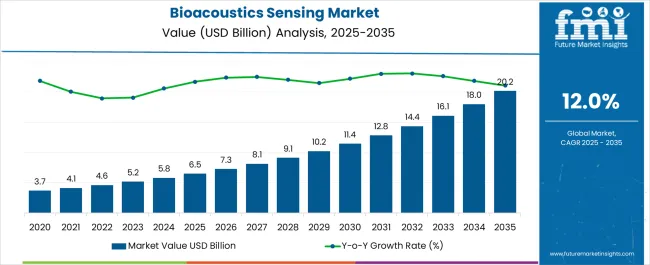
| Metric | Value |
|---|---|
| Bioacoustics Sensing Market Estimated Value in (2025 E) | USD 6.5 billion |
| Bioacoustics Sensing Market Forecast Value in (2035 F) | USD 20.2 billion |
| Forecast CAGR (2025 to 2035) | 12.0% |
The bioacoustics sensing market is witnessing steady expansion, driven by the increasing adoption of sound-based monitoring systems across healthcare, environmental, and industrial applications. Growth is being supported by advances in acoustic sensors, signal processing, and machine learning algorithms that enable real-time detection and analysis of biological and environmental sounds.
Rising interest in non-invasive health monitoring techniques is further fueling demand for bioacoustic solutions, as these systems offer the ability to capture physiological signals without direct physical intervention. Expanding use cases in biodiversity research, ecosystem monitoring, and wildlife conservation are also strengthening the market outlook, with governments and organizations investing in sound-based technologies to track species and preserve natural habitats.
The ability of bioacoustics sensing platforms to combine low-power hardware with advanced software is creating new opportunities for scalable deployments in both developed and emerging economies As sensor miniaturization and cloud-based analytics continue to improve, the market is positioned to achieve strong long-term growth, supported by heightened emphasis on sustainability, healthcare innovation, and precision monitoring.
The bioacoustics sensing market is segmented by component, application, and geographic regions. By component, bioacoustics sensing market is divided into Hardware, Detectors, Sound Recorders, Microphones, Software, Audio & Video Software, Sound Analytic Software, Others, and Services. In terms of application, bioacoustics sensing market is classified into Healthcare, Wearable, Consumer Electronics, and Others. Regionally, the bioacoustics sensing industry is classified into North America, Latin America, Western Europe, Eastern Europe, Balkan & Baltic Countries, Russia & Belarus, Central Asia, East Asia, South Asia & Pacific, and the Middle East & Africa.
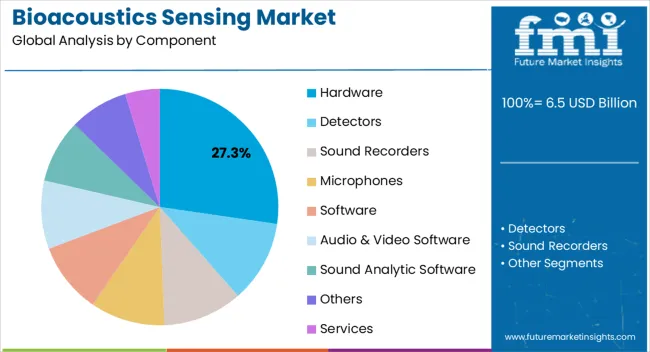
The hardware segment is projected to account for 27.3% of the bioacoustics sensing market revenue share in 2025, making it a leading contributor. Its prominence is being supported by the essential role of microphones, sensors, and recording devices that capture sound signals for further processing. Continuous advancements in hardware design, including miniaturization, improved sensitivity, and low-power operation, are enabling wider adoption in portable and wearable devices.
The growing need for robust and durable hardware in field deployments, such as wildlife monitoring and industrial environments, is reinforcing its market demand. Hardware investments are also being accelerated by the increasing integration of edge computing capabilities, allowing data pre-processing at the device level and reducing reliance on centralized systems.
As healthcare and environmental research expand their reliance on sound-based monitoring, reliable hardware platforms are becoming critical enablers of large-scale data collection The segment’s continued growth is expected to be reinforced by collaborations between sensor manufacturers, research institutions, and technology providers aiming to develop cost-effective and high-performance acoustic sensing devices tailored for diverse applications.
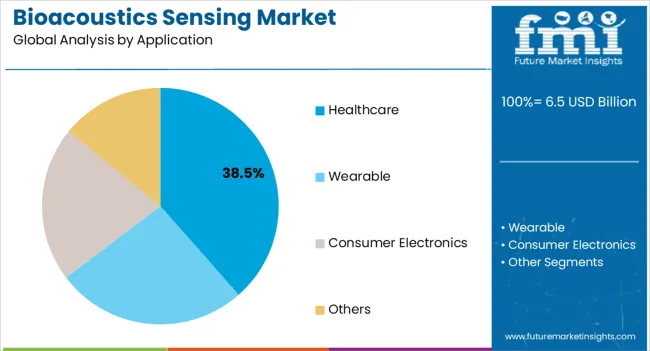
The healthcare segment is anticipated to capture 38.5% of the bioacoustics sensing market revenue share in 2025, establishing itself as the leading application. Its dominance is being driven by the rising need for non-invasive monitoring tools that leverage acoustic signals to assess physiological functions such as respiratory health, cardiovascular conditions, and fetal development. Bioacoustic sensing technologies are being increasingly integrated into wearable devices and remote monitoring systems, enabling continuous and real-time assessment of patient health without invasive procedures.
Growing demand for personalized healthcare and early disease detection is further reinforcing adoption in both clinical and homecare settings. Healthcare providers are recognizing the potential of bioacoustic sensing to improve diagnostic accuracy and enhance patient outcomes while reducing healthcare costs.
Regulatory support for digital health solutions and advancements in AI-driven analysis of acoustic data are also contributing to this segment’s leadership As populations age and the need for chronic disease management increases, bioacoustic sensing in healthcare is expected to play a pivotal role in improving preventive care, treatment monitoring, and patient engagement globally.
Bioacoustics is a cross-disciplinary science which combines acoustics and biology. Bioacoustics sensing combine sensing technology, biology, machine learning, and acoustics technology. It refers to investigation of the sound production, and dispersion and uses digital technology that includes software and devices that are used to analyze and record the sound.
Bioacoustics sensing is used for identifying, locating the animals and their condition and is also used in humans for medical applications, such as detecting cancer, reducing cancer tumors, monitoring blood pressure, respiratory system monitoring. Bioacoustics sensing is also used in consumer electronics such as smartphones, laptops and wearable devices.
Bioacoustics sensing is gaining popularity in sectors including healthcare and wearable consumer electronics. It is also used in agriculture and ecology for identifying and detecting the parasites to protect crops.
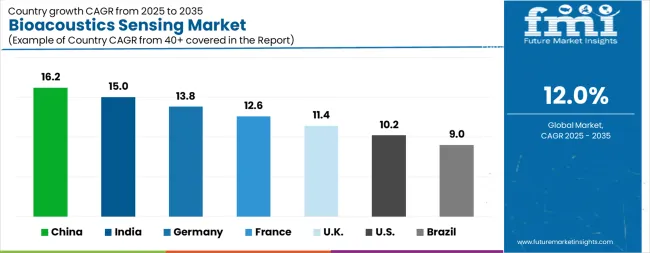
| Country | CAGR |
|---|---|
| China | 16.2% |
| India | 15.0% |
| Germany | 13.8% |
| France | 12.6% |
| UK | 11.4% |
| USA | 10.2% |
| Brazil | 9.0% |
The Bioacoustics Sensing Market is expected to register a CAGR of 12.0% during the forecast period, exhibiting varied country level momentum. China leads with the highest CAGR of 16.2%, followed by India at 15.0%. Developed markets such as Germany, France, and the UK. continue to expand steadily, while the USA is likely to grow at consistent rates. Brazil posts the lowest CAGR at 9.0%, yet still underscores a broadly positive trajectory for the global Bioacoustics Sensing Market. In 2024, Germany held a dominant revenue in the Western Europe market and is expected to grow with a CAGR of 13.8%. The USA Bioacoustics Sensing Market is estimated to be valued at USD 2.5 billion in 2025 and is anticipated to reach a valuation of USD 6.5 billion by 2035. Sales are projected to rise at a CAGR of 10.2% over the forecast period between 2025 and 2035. While Japan and South Korea markets are estimated to be valued at USD 314.9 million and USD 200.1 million respectively in 2025.
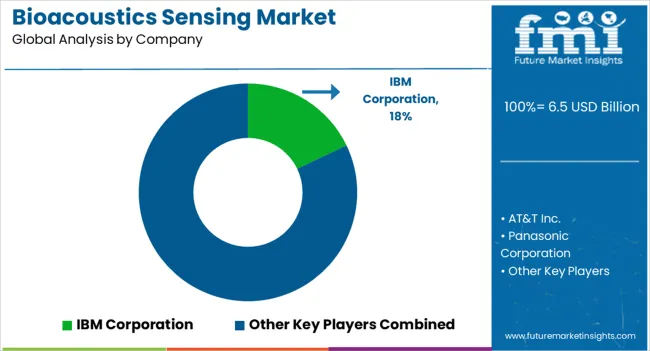
| Item | Value |
|---|---|
| Quantitative Units | USD 6.5 Billion |
| Component | Hardware, Detectors, Sound Recorders, Microphones, Software, Audio & Video Software, Sound Analytic Software, Others, and Services |
| Application | Healthcare, Wearable, Consumer Electronics, and Others |
| Regions Covered | North America, Europe, Asia-Pacific, Latin America, Middle East & Africa |
| Country Covered | United States, Canada, Germany, France, United Kingdom, China, Japan, India, Brazil, South Africa |
| Key Companies Profiled | IBM Corporation, AT&T Inc., Panasonic Corporation, Honeywell International Inc., Avisoft Bioacoustics, Med-Acoustics, Remon Medical Technologies, and Pacesetter Inc |
The global bioacoustics sensing market is estimated to be valued at USD 6.5 billion in 2025.
The market size for the bioacoustics sensing market is projected to reach USD 20.2 billion by 2035.
The bioacoustics sensing market is expected to grow at a 12.0% CAGR between 2025 and 2035.
The key product types in bioacoustics sensing market are hardware, detectors, sound recorders, microphones, software, audio & video software, sound analytic software, others and services.
In terms of application, healthcare segment to command 38.5% share in the bioacoustics sensing market in 2025.






Our Research Products

The "Full Research Suite" delivers actionable market intel, deep dives on markets or technologies, so clients act faster, cut risk, and unlock growth.

The Leaderboard benchmarks and ranks top vendors, classifying them as Established Leaders, Leading Challengers, or Disruptors & Challengers.

Locates where complements amplify value and substitutes erode it, forecasting net impact by horizon

We deliver granular, decision-grade intel: market sizing, 5-year forecasts, pricing, adoption, usage, revenue, and operational KPIs—plus competitor tracking, regulation, and value chains—across 60 countries broadly.

Spot the shifts before they hit your P&L. We track inflection points, adoption curves, pricing moves, and ecosystem plays to show where demand is heading, why it is changing, and what to do next across high-growth markets and disruptive tech

Real-time reads of user behavior. We track shifting priorities, perceptions of today’s and next-gen services, and provider experience, then pace how fast tech moves from trial to adoption, blending buyer, consumer, and channel inputs with social signals (#WhySwitch, #UX).

Partner with our analyst team to build a custom report designed around your business priorities. From analysing market trends to assessing competitors or crafting bespoke datasets, we tailor insights to your needs.
Supplier Intelligence
Discovery & Profiling
Capacity & Footprint
Performance & Risk
Compliance & Governance
Commercial Readiness
Who Supplies Whom
Scorecards & Shortlists
Playbooks & Docs
Category Intelligence
Definition & Scope
Demand & Use Cases
Cost Drivers
Market Structure
Supply Chain Map
Trade & Policy
Operating Norms
Deliverables
Buyer Intelligence
Account Basics
Spend & Scope
Procurement Model
Vendor Requirements
Terms & Policies
Entry Strategy
Pain Points & Triggers
Outputs
Pricing Analysis
Benchmarks
Trends
Should-Cost
Indexation
Landed Cost
Commercial Terms
Deliverables
Brand Analysis
Positioning & Value Prop
Share & Presence
Customer Evidence
Go-to-Market
Digital & Reputation
Compliance & Trust
KPIs & Gaps
Outputs
Full Research Suite comprises of:
Market outlook & trends analysis
Interviews & case studies
Strategic recommendations
Vendor profiles & capabilities analysis
5-year forecasts
8 regions and 60+ country-level data splits
Market segment data splits
12 months of continuous data updates
DELIVERED AS:
PDF EXCEL ONLINE
Sensing Cable Market
Self Sensing Nanocomposites Market Size and Share Forecast Outlook 2025 to 2035
Depth Sensing Market Trends - Growth & Forecast 2025 to 2035
Remote Sensing Services Market Trends - Growth & Forecast 2025 to 2035
Inertial Sensing Products Market Size and Share Forecast Outlook 2025 to 2035
Touchless Sensing Market Size and Share Forecast Outlook 2025 to 2035
Multi Touch Sensing Market Size and Share Forecast Outlook 2025 to 2035
Temperature Sensing Foley Catheter Market
Distributed Temperature Sensing Systems Market Size and Share Forecast Outlook 2025 to 2035
Non-Dispersive Infrared Sensing Market

Thank you!
You will receive an email from our Business Development Manager. Please be sure to check your SPAM/JUNK folder too.
Chat With
MaRIA